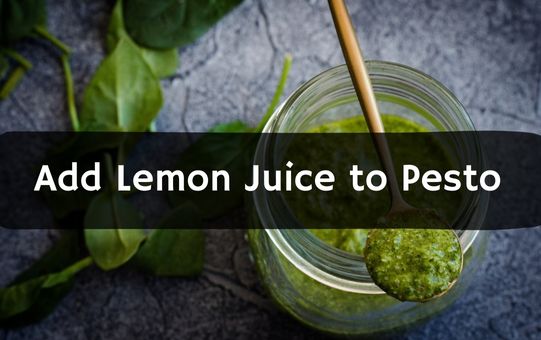If you enjoy pesto, you may wonder if can you add lemon juice to pesto. Actually, lemon juice can enhance the flavor of pesto.
Traditional Italian pesto is composed of fresh basil, pine nuts, Parmesan cheese, garlic, and olive oil. It is a condiment that can be utilized in a variety of dishes, including pasta, sandwiches, and pizzas.
In this article, we will explore the possibilities of adding lemon juice to pesto.
Contents
Why Add Lemon Juice to Pesto matter?
Lemon juice is a common ingredient in many sauces and dressings because it adds a burst of acidity and freshness. It can help to balance out rich or fatty flavors, and it can also enhance the flavors of other ingredients. So, adding a little lemon juice to your pesto may seem like a natural choice.
But before we get too carried away with our lemon juice experimentation, it’s important to consider the flavor profile of traditional pesto.
Pesto is typically a bright, fresh, and herbaceous sauce, with the basil and pine nuts providing a lot of the flavor. Lemon juice, on the other hand, is a tart and acidic ingredient that can overpower more delicate flavors.
This means that adding lemon juice to pesto requires a bit of finesse and balance. It’s important to consider how much lemon juice you’re adding, as well as the other ingredients in your pesto.
Read Also: Can You Add Lemon Juice To The Rice?
How to Add Lemon Juice to Pesto?
If you do decide to add lemon juice to your pesto, there are a few different approaches you can take. One option is to simply squeeze a little lemon juice into the sauce as you’re making it. You can start with just a small amount (perhaps a teaspoon or so) and then taste the pesto to see if you’d like to add more.
Another option is to incorporate lemon juice into the pesto by using lemon zest instead of juice. Lemon zest is the outermost layer of the lemon peel, and it adds a bright, citrusy flavor to dishes without the tartness of the juice. To use lemon zest in your pesto, simply zest the lemon using a grater or zester and mix the zest into the sauce.
If you’re using lemon zest, you may want to reduce the amount of other acidic ingredients (such as vinegar or tomatoes) in your pesto, as the lemon zest will already be adding some acidity to the sauce.

When to Add Lemon Juice to Pesto?
One of the best times to add lemon juice to pesto is when the sauce is being used as a marinade or dressing. Lemon juice can help to tenderize meats and vegetables, and it can also give the pesto a brighter, fresher flavor.
For example, you might mix a little lemon juice into your pesto and use it as a marinade for grilled chicken or fish. Or, you could toss some blanched vegetables in lemon juice and pesto dressing for a bright and flavorful side dish.
You could also consider adding lemon juice to your pesto when you’re using it as a topping for pizzas or sandwiches. The lemon juice can help to cut through the richness of the cheese and other toppings, and it can add a refreshing burst of flavor to your dish.
How Much Lemon Juice to Add to Pesto?
When it comes to adding lemon juice to pesto, it’s important to start with a small amount and then taste and adjust as needed. A little goes a long way when it comes to lemon juice, and it’s easy to accidentally overdo it.
As a general rule, it’s a good idea to start with just a teaspoon or so of lemon juice and then taste the pesto to see if you’d like to add more. You can always add more lemon juice if you feel like the sauce could use a little more acidity, but it’s difficult to take the lemon juice back once it’s been added.
Another thing to consider is the other ingredients in your pesto. If you’re using a lot of acidic ingredients (such as vinegar or tomatoes), you may want to use less lemon juice, or omit it altogether. On the other hand, if your pesto is on the mild side, a little lemon juice can help to balance out the flavors and add some brightness to the sauce.
It’s also worth noting that the flavor of lemon juice can change as it cooks, so it’s a good idea to taste the pesto after it’s been heated up to see if the lemon flavor is still balanced with the other ingredients.
Tips for Adding Lemon Juice to Pesto
Here are a few tips to keep in mind when adding lemon juice to your pesto:
- Start with a small amount of lemon juice and then taste and adjust as needed. It’s easier to add more lemon juice than it is to take it away.
- Consider using lemon zest instead of juice for a brighter, fresher flavor.
- Think about the other ingredients in your pesto and how they might be affected by the addition of lemon juice. If you’re using a lot of acidic ingredients, you may want to use less lemon juice, or omit it altogether.
- Taste the pesto after it’s been heated up to see if the lemon flavor is still balanced with the other ingredients.
- Experiment and have fun! Pesto is a versatile sauce, and adding a little lemon juice can be a great way to switch things up and add some brightness to your dishes.
Read Also: Can You Add Lemon Juice to Royal Icing?
Conclusion
It is possible to add lemon juice to pesto, but it’s important to do so with caution and balance. Start with a small amount and then taste and adjust as needed, considering the other ingredients in your pesto and how they might be affected by the addition of lemon juice. With a little finesse, you can create a delicious and refreshing pesto sauce that’s perfect for a variety of dishes.
Faq’s|Add Lemon Juice to Pesto
Add lemon juice to pesto just like you would add water to a recipe. It is an important part of the flavor and texture of pesto and should not be omitted.
Can You Add Lemon Juice To The Pesto?
Yes, it is possible to add lemon juice to pesto. However, it’s important to use caution and balance, as lemon juice is a tart and acidic ingredient that can overpower more delicate flavors. It’s a good idea to start with a small amount of lemon juice and then taste and adjust as needed.
Why Add Lemon Juice To Pesto?
Lemon juice is a common ingredient in many sauces and dressings because it adds a burst of acidity and freshness. It can help to balance out rich or fatty flavors, and it can also enhance the flavors of other ingredients.
Adding a little lemon juice to the pesto may give the sauce a bright, citrusy twist.
How Do You Add Lemon Juice To Pesto?
There are a few different ways to add lemon juice to pesto. One option is to simply squeeze a little lemon juice into the sauce as you’re making it.
Another option is to incorporate lemon juice by using lemon zest instead of juice. To use lemon zest, simply zest the lemon using a grater or zester and mix the zest into the sauce.
When Is The Best Time To Add Lemon Juice To Pesto?
One of the best times to add lemon juice to pesto is when the sauce is being used as a marinade or dressing. Lemon juice can help to tenderize meats and vegetables, and it can also give the pesto a brighter, fresher flavor.
You could also consider adding lemon juice to pesto when you’re using it as a topping for pizzas or sandwiches.
How Much Lemon Juice Should You Add To The Pesto?
It’s important to start with a small amount of lemon juice and then taste and adjust as needed. A little goes a long way when it comes to lemon juice, and it’s easy to accidentally overpower the other flavors in the sauce.
As a general rule, it’s a good idea to start with just a teaspoon or so of lemon juice and then taste the pesto to see if you’d like to add more.

